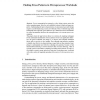Free Online Productivity Tools
i2Speak
i2Symbol
i2OCR
iTex2Img
iWeb2Print
iWeb2Shot
i2Type
iPdf2Split
iPdf2Merge
i2Bopomofo
i2Arabic
i2Style
i2Image
i2PDF
iLatex2Rtf
Sci2ools
HIPEAC
2009
Springer
2009
Springer
Finding Stress Patterns in Microprocessor Workloads
Power consumption has emerged as a key design concern across the entire computing range, from low-end embedded systems to high-end supercomputers. Understanding the power characteristics of a microprocessor under design requires a careful study using a variety of workloads. These workloads range from benchmarks that represent typical behavior up to hand-tuned stress benchmarks (so called stressmarks) that stress the microprocessor to its extreme power consumption. This paper closes the gap between these two extremes by studying techniques for the automated identification of stress patterns (worst-case application behaviors) in typical workloads. For doing so, we borrow from sampled simulation theory and we provide two key insights. First, although representative sampling is slightly less effective in characterizing average behavior than statistical sampling, it is substantially more effective in finding stress patterns. Second, we find that threshold clustering is a better alternati...
Hand-tuned Stress Benchmarks | HIPEAC 2009 | Power Consumption | Stress Patterns | System Software |
| Added | 19 May 2010 |
| Updated | 19 May 2010 |
| Type | Conference |
| Year | 2009 |
| Where | HIPEAC |
| Authors | Frederik Vandeputte, Lieven Eeckhout |
Comments (0)

